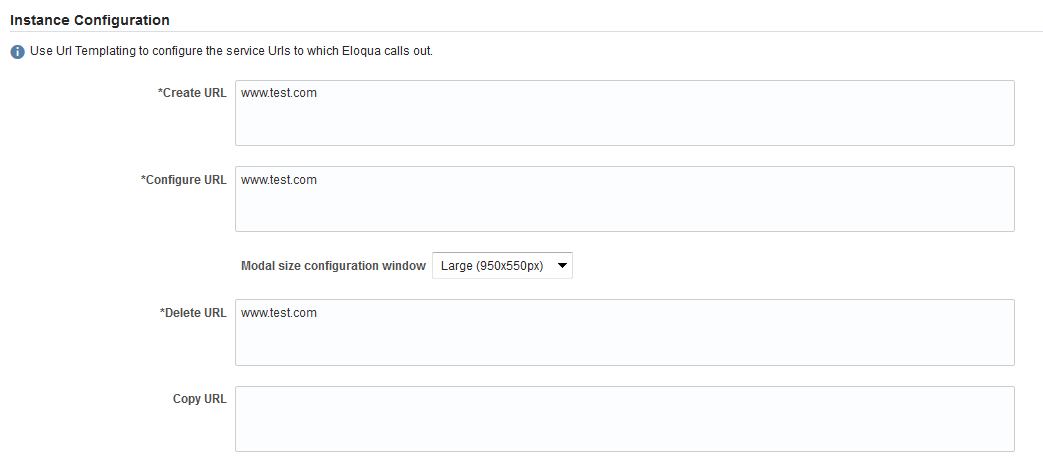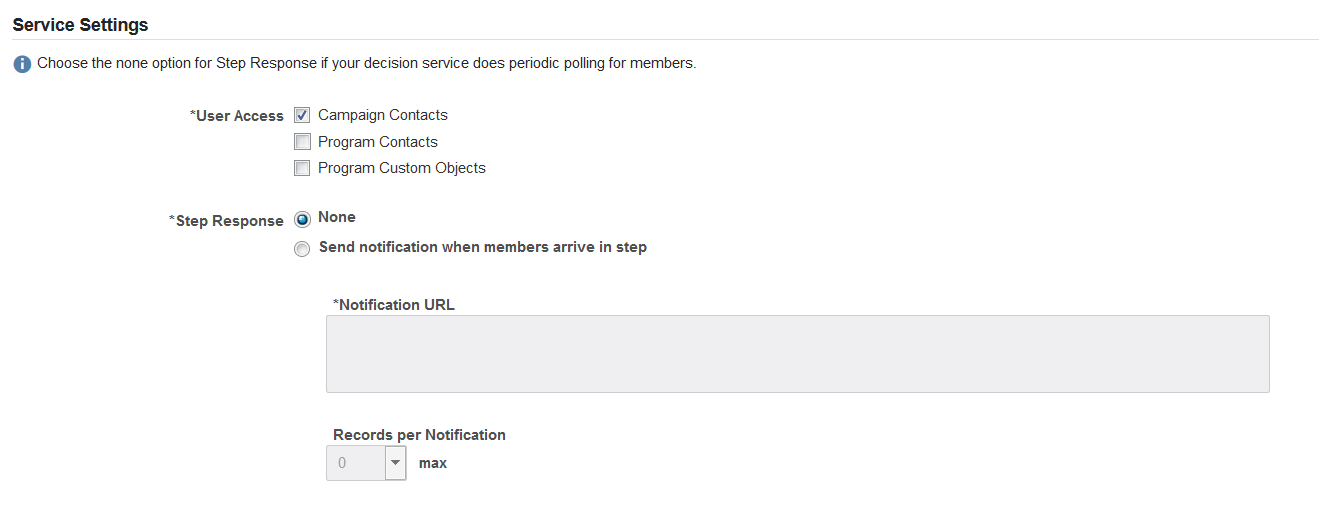Register a Decision Service
With Decisions, developers can build apps that directly control the path a contact takes as they flow through a campaign. For instance, you could build an App that Eloqua calls out to when contacts reach a Decision step. This App might interact with an external system, and evaluate rules against that set of external data. The App then responds, telling Eloqua whether the contacts should flow through the step’s “yes” or “no” path. With Decisions, the data used in the decision never needs to be brought into Eloqua.
When you set up a Decision service, you will need to provide the usual AppCloud Developer framework service details, as well as the Instance Configuration, Content-Type of the notification POST call and Decision Settings.
Service Details
These fields are present for all services:
- Name: the name of the service. Max length: 100 characters.
- Description: describes what the service does. Max length: 4000 characters.
- 16x16px Icon: the URL of the icon Eloqua displays when your service is displayed on a canvas. The icon will be 16px by 16px when displayed. It must be a secure URL. See App icon design guidelines for more information on designing app icons.
- 32x32px Icon: the URL of the icon that Eloqua should display for your service. The icon will be 32px by 32px when displayed. It must be a secure URL. See App icon design guidelines for more information on designing app icons.
Instance Configuration
This section defines the URLs for creating, configuring, copying, and deleting an instance of your service. The installation tutorial details the instance creation flow when a marketer drags an Decision step onto the canvas, and selects your app.
Each URL is a templated URL that uses common URL template parameters and some Eloqua markup language parameters. Eloqua replaces these paramters with their appropriate values when it makes a call. For more about URL templating, see our Introduction to URL templating.
-
Create URL: A templated URL pointing to a web portal for creating an instance of this service as an HTTP
POSTrequest. All common URL template parameters are available.You should be sure to include, at a minimum, the
{InstanceId}parameter so that you will be able to identify the service in the future. On success, this endpoint should return a 200-level response with the created instance. -
Configure URL: A templated URL pointing to an endpoint for configuring an instance of this service as an HTTP
GETrequest. All common URL template parameters are available.You should be sure to include, at a minimum, the
{InstanceId}parameter so that you will be able to identify the service in the future. -
Modal size configuration window: Select a modal size for your configuration window. The configuration page displays when marketers configure your service.
- Large: 950px x 550px
- Small: 650px x 550px
-
Delete URL: A templated URL pointing to an endpoint for deleting an instance of this service using an HTTP
DELETErequest. All common URL template parameters are available. On success, this endpoint should return a 200-level response. -
Copy URL: A templated URL pointing to an endpoint for creating an instance of this service as an HTTP
POSTrequest. All common URL template parameters are available in addition to{OriginalInstanceId},{OriginalInstallId},{OriginalAssetId}, and{OriginalAssetName}.You should be sure to include, at a minimum, the
{InstanceId}and{OriginalInstanceId}parameters so that you can identify the original and newly created instances. On success, this endpoint should return a 200-level response with the created instance. Learn how to Respond when a marketer copies a service instance.
Service Settings
- User Access: Select the Eloqua services for which your app should be available.
- Step Response: Specify whether Eloqua should call out to your service when a member arrives in the decision step, or whether your application will poll for members periodically.
-
Notification URL: A templated URL to an endpoint for notifying the external service, during execution, to get the decision result of the configured instance. If this property is not specified, the system will fall back to a polling style approach without any notification.
- Records per Notification: Max number of records to push per HTTP request (between 0 and 5,000). If set to 0, apps must be developed to retrieve records, see the tutorial Retrieving app records using the bulk API for more information.
When you’re done configuring your service, click Save. A green alert message will appear at the top of the page indicating the service has been successfully saved.

